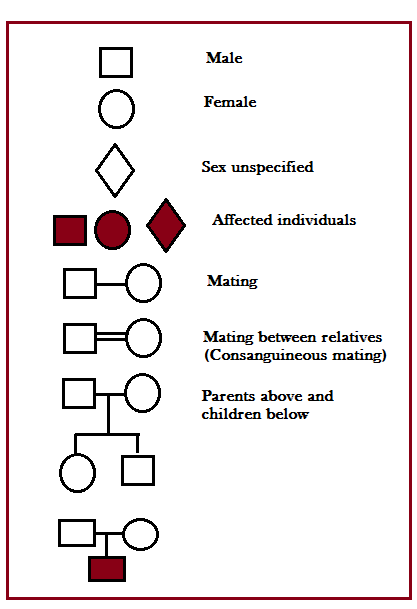Pedigree analysis is a genetic method of determining the pattern of inheritance of a trait in different generations. For example, if a disease is present in two generations, it would be wise to see the pattern and find the probability of the occurrence of the disease in the next generation. Geneticists often use pedigree analysis to find a disease pattern in families.
Pedigree analysis involves the use of symbols. It is, therefore, important to understand the meaning of each symbol. These symbols are mentioned below:

There are four different kinds of inheritance in pedigree analysis. They are as follows:
- Autosomal dominant trait: Huntington disease, polycystic kidney disease
- Autosomal recessive trait: cystic fibrosis, PKU, Tay Sachs disease, sickle cell anemia
- X-linked dominant trait: Rett syndrome, Fragile X-syndrome
- X-linked recessive trait: Haemophilia, color blindness
Tips to Solving Pedigree Problems:
Autosomal Dominant Trait
- There should not be any skipping of generations. In the given pedigree below, in every generation, disease is present. This is called no skipping of generation.

If an affected person marries an unaffected or normal person, there should be approximately 50% chance of offspring being affected. In other words, 50% diseased and 50% normal offspring would form. In other words, affected men and women transmit disease in equal proportions.

- If affected father transfers disease to his son only then it is always autosomal dominant trait.

- If parents don’t have the trait, their children should not have the trait

Example:

Explanation:
- In the given example above, it is a three generation pedigree. We can see that in each generation, disease is present meaning there is no skipping of generation. So, it is a dominant pedigree.
- In the first generation, the female is diseased and the male is normal – in such as case, half of the offspring would be affected and half would be normal. We can see in the second generation that out of 4 offspring, 2 offspring are normal and two are diseased.
- On the basis of the above two tips, we can conclude that the pedigree shows autosomal dominant trait.
- If it was X-linked dominant trait, the affected female would pass the disease to both male and female.
X-linked Dominant Trait:
- There is no male-to-male transmission – the affected father will transmit the disease to daughters only and no sons.

- Sons can have the trait only if their mother also has the trait

- Should follow DDD rule (D=dominant; D= diseased dad; D = diseased daughters) – it means if father is diseased, all daughters will be diseased but no sons. Besides, the father’s mother must also be diseased.

Example:

Explanation:
- In the above example, there is no skipping of generation and that’s why it is a dominant pedigree.
- It follows DDD rule. In the first generation, father is affected and he transmits disease to his daughters only.
- If mother is affected, she can transmit disease to both sons and daughters as we can see in the second generation, mother is affected and transmitting disease to both sons and daughters in the third generation.
Autosomal Recessive Trait
- There is skipping of generation
- Unaffected parents can have affected offspring

- Male and female have the same chance of expressing the trait
- If both parents have the disease, all their offspring should also express the disease
- Traits are often found in pedigrees with consanguineous marriages

Explanation:
- The above pedigree shows skipping of generation because in the first generation, there is no disease, but it appears in the second generation. There is no disease in the third generation. It means, disease has not been transmitted to every generation. So, it is a recessive pedigree.
- Unaffected parents can have affected offspring – this can be seen in the first and second generation.
- In autosomal recessive pedigree, both male and female have equal chance of expressing the trait – we can see that in the second generation, one male one female are affected.
X-linked Recessive Trait:
- Skipping of generation
- Most of the affected individuals are males
- The trait is more common in males than in females because females can be carriers.
- If a mother has the trait, all her sons should have it

- There is no male to male transmission
- Approximately 50% of the sons of carrier females should be affected

Explanation:
- There is skipping of generation in the above pedigree because disease is not present in every generation.
- Affected mother will affect all her sons. We can see that in the second generation an affected mother transmits disease to all her sons in the third generation.
- More males are affected than females
Let’s discuss a question: In the given pedigree, find out the nature of pedigree.

In the above example, there is not skipping of generation (disease). Disease is present in the I, II and III generation. It means, it is a dominant pedigree. It would be wise to check if it is X-linked dominant pedigree. Son has the trait if the mother also has the trait. Well, it is true for the I and II generation, but if you see in the II generation, mother is affected but she does not transmit the disease in the III generation to her son. So, it cannot be X-linked dominant rather autosomal dominant trait.
